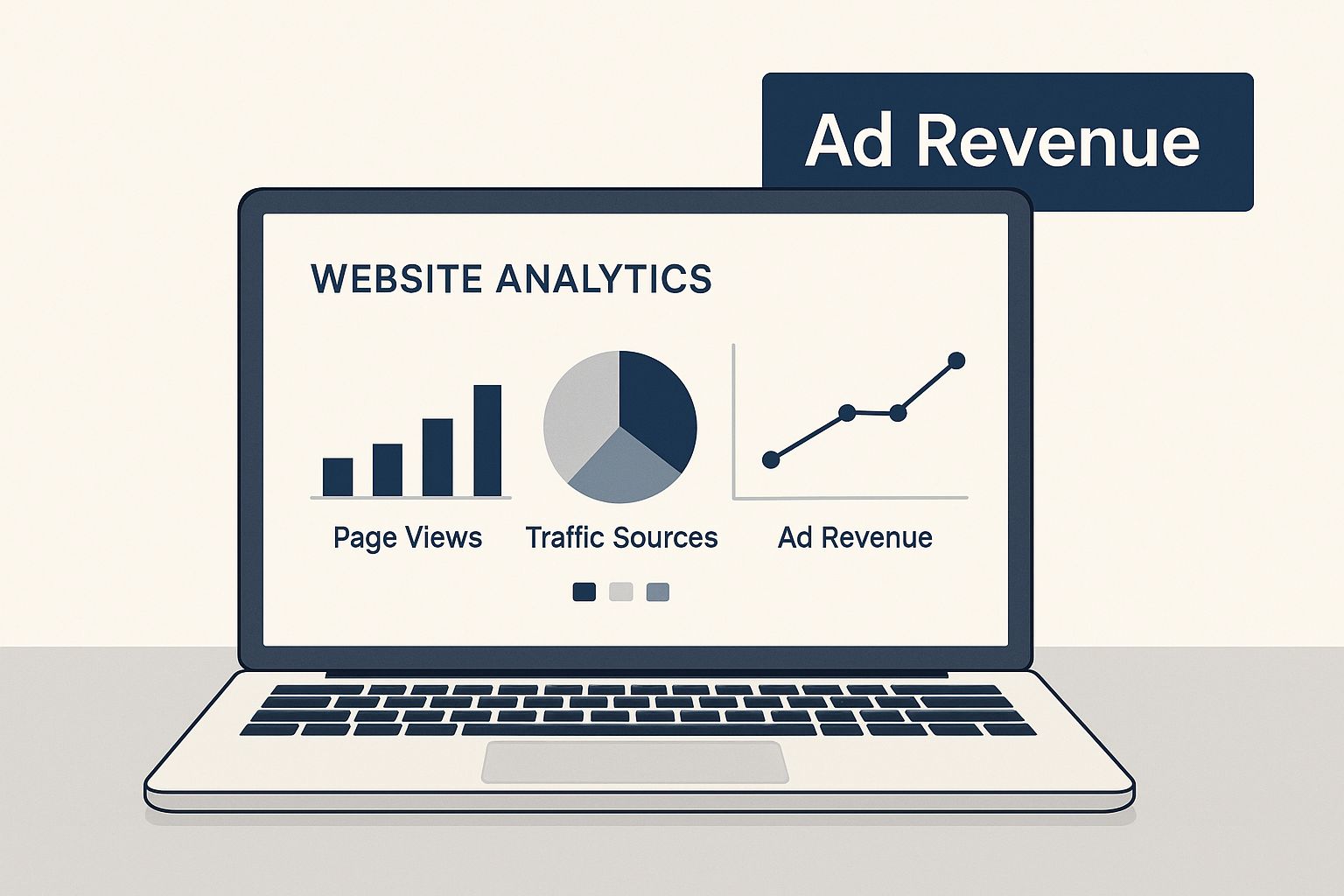Understanding What Actually Works in Today’s Creator Economy
The creator economy? It’s a different beast than it used to be. Forget that old-school advice about just posting regularly and raking in the cash. I’ve chatted with creators earning six figures, and the truth is way more complex. It’s not about follower count; I’ve literally seen creators with 10,000 engaged followers making more than those with 100,000.
The real magic? Treating your audience like a close-knit group, not just a bunch of numbers on a screen.
This boils down to understanding what makes your audience tick. What are their real needs and pain points? This focus lets you fine-tune your content and monetization strategies to really hit the mark. Want to get a better grip on the creator economy? Dive into strategies that boost social media engagement. Genuine connection trumps chasing viral fame, every time.
The platforms you pick also play a huge role. Don’t stretch yourself thin trying to be everywhere at once. Instead, double down on the platforms where your target audience hangs out and your content style shines. It’s like fishing – you wouldn’t cast your line in every single pond, right? You’d go where you know the fish are biting.
And let’s talk about growth. The creator economy has exploded in recent years. Since 2020, over 165 million new creators have jumped onto social media platforms, transforming their passions into profitable brands. This shift means 2 in 10 creators are now running their own content-based businesses. Discover more insights about the creator economy’s growth.
This screenshot shows just how much the creator economy is projected to grow (and the potential revenue it holds!). It highlights the massive opportunities out there for creators who know how to effectively monetize their content. This isn’t just a hobby anymore; it’s a serious business.
Think about a food blogger with a small but dedicated following. They focus on hyperlocal recipes and build relationships with local farmers markets. This niche approach might not attract millions of followers, but it creates a fiercely loyal community. This allows them to land local sponsorships, host small, intimate cooking classes, and sell specialized recipe ebooks—all perfectly aligned with their audience.
That’s the power of knowing your audience and tailoring your monetization strategy accordingly. It’s not about chasing the latest trend; it’s about building genuine connections. These connections, in turn, unlock a ton of monetization options that go way beyond basic ad revenue. This approach builds a lasting business, not just viral flashes in the pan. It’s about long-term value, both for the creator and their community. This deep understanding of today’s creator landscape is the real difference between creators earning a good living and those still struggling to make it work.
Making Ad Revenue Work For You Instead of Against You
Let’s be real, ad revenue isn’t some magical passive income stream. It’s not as simple as throwing ads onto your content and watching the money roll in. It takes work, and it takes understanding the nuances of the system. But trust me, when you figure out how it actually works, ad revenue can become a serious powerhouse in your monetization strategy.
One of the biggest keys is knowing your audience. A channel about luxury yachts is going to attract different advertisers (with deeper pockets) than a channel reviewing children’s books. Think about who you’re reaching and the types of products or services they’d be interested in. Similarly, watch time is gold, especially on platforms like YouTube. Longer watch times tell advertisers that your viewers are engaged, and that makes your content more valuable. Choosing the right niche also matters. Some topics are simply more appealing to advertisers. Finance, tech, and business content, for instance, often command higher ad rates.
Timing is another factor that often gets overlooked. Publishing content when your audience is online and ready to engage can seriously impact your RPM (Revenue Per Mille) – that’s how much you earn per thousand views. I’ve personally seen creators double their RPM just by tweaking their upload schedule. It’s not enough to create great content; you have to get it in front of the right people at the right time. This image shows a glimpse into the world of ad revenue analytics. 
And don’t forget about those platform-specific monetization features. Many platforms offer bonus programs or premium ad formats that can boost your earnings. Just be careful; not all features are created equal. Some can actually be more distracting than helpful. Stick with the ones that align with your content and your audience. Speaking of platforms, social media is a giant in the advertising world. Social media ad spending is projected to reach $276.7 billion by 2025. And a whopping 83% of that spend is expected to come from mobile by 2030. Video is king, too, with 78% of people preferring to learn about products through short videos and 93% of marketers ramping up their social video efforts. Want to dive deeper into the numbers? Check out these social media statistics.
Maximizing Your Ad Revenue Potential
So, how do you put this all into action? First, focus on the metrics advertisers care about, not just vanity metrics like follower count. Engagement (likes, comments, shares) and click-through rates are much more valuable in the ad world. A solid understanding of influencer marketing can be beneficial here. Second, explore different ways to monetize your videos. There are tons of video monetization strategies out there, so do your research and find what works for you. Third, be patient. Building a significant income from ads takes time and effort. Don’t expect to get rich quick. This screenshot from the YouTube Creator Studio shows the resources creators have for managing and monetizing their channels. 
To understand the varying requirements and potential earnings across different platforms, take a look at this table:
Platform Monetization Requirements and Earning Potential
Comparison of minimum requirements and average earnings across major content platforms
| Platform | Minimum Requirements | Average CPM | Additional Features |
|---|---|---|---|
| YouTube | 1,000 subscribers, 4,000 valid watch hours | $2-$10 | Channel memberships, Super Chat, merchandise shelf |
| TikTok | 10,000 followers, 100,000 video views in the last 30 days | $2-$4 | Creator Fund, Creator Marketplace |
| 10,000 followers | $2-$5 | Badges, Shopping, Brand Collabs Manager | |
| Twitch | 50 followers, 500 total minutes broadcast, 7 unique broadcast days, an average of 3 concurrent viewers | $2-$5 | Subscriptions, donations, bits |
This table provides a general overview and the actual figures can fluctuate based on various factors. Remember, these are just averages, and your earnings can vary significantly based on your niche, engagement, and other factors.
Finally, remember that building a successful online presence is about more than just ad revenue. Diversification is key. Think about sponsorships, affiliate marketing, or even creating your own digital products or courses. By combining these strategies, you create a more stable and sustainable business model.
Landing Brand Partnerships That Actually Pay Well
Let’s talk sponsorships. I’m going to let you in on a little secret: most creators approach them the wrong way, and they’re missing out on serious cash. I’ve learned a lot from creators who regularly score five-figure deals, and they’ve shared their tips on how to position yourself as a valuable partner, not just another influencer asking for freebies. This isn’t about begging; it’s about building relationships that benefit everyone involved.
Identifying the Right Brand Partners
Forget blasting out emails to every brand under the sun. Instead, focus on brands that truly align with your audience and your content. If you’re all about gaming, partnering with a skincare brand probably won’t make sense. But a gaming hardware company? Bingo. Think of it like dating – the better the match, the better the relationship.
Crafting Outreach That Gets Noticed
Your outreach emails need to cut through the clutter. Generic pitches go straight to the trash. Personalize your message! Mention something specific you appreciate about the brand, or how your audience overlaps with theirs. Show them you’ve done your research. Imagine a brand gets an email saying, “I love your new sustainable packaging!” versus “I want to collab.” Which one are they going to read?
This screenshot from the AspireIQ Creator Marketplace – a platform that connects brands and creators – highlights the importance of a professional and attractive profile. Showcase your best work and highlight what makes you special. It’s your digital storefront.
Negotiating Contracts That Protect Your Interests
When a brand expresses interest, don’t shy away from negotiation. Know your worth! Clearly define the deliverables, payment terms, and usage rights. A well-written contract protects both you and the brand, and it sets the foundation for a lasting partnership, which is way more valuable than a one-time gig. Want to dive deeper into the ROI of influencer marketing? Check out our guide on influencer marketing ROI.
Pricing Psychology: The Art of Charging What You’re Worth
This is where a lot of creators stumble. They underestimate their value and undercharge, big time. You need to understand what you bring to the table. Don’t just focus on follower count. Think about your engagement rate, the quality of your content, and what the brand specifically needs.
To help you get a sense of potential pricing, I’ve put together a handy table:
Sponsorship Pricing Guide by Platform and Audience Size
Recommended pricing structure for sponsored content across different platforms and follower counts
| Follower Range | Instagram Post | YouTube Video | TikTok Video | Blog Post |
|---|---|---|---|---|
| 10k-50k | $250-$750 | $500-$1500 | $200-$600 | $300-$800 |
| 50k-100k | $750-$1500 | $1500-$3000 | $600-$1200 | $800-$1500 |
| 100k-500k | $1500-$5000 | $3000-$10,000 | $1200-$4000 | $1500-$5000 |
| 500k+ | $5000+ | $10,000+ | $4000+ | $5000+ |
Keep in mind these are just estimates, and pricing can vary based on factors like niche and campaign specifics. It’s always a good idea to research industry standards and tailor your pricing accordingly.
Thinking Beyond Sponsored Posts: Unlocking Ongoing Revenue
Sponsorships are just the beginning. Explore other partnership options, like product collaborations or brand ambassador programs. These can create ongoing revenue streams and build stronger brand relationships. A product collaboration could involve co-creating a limited-edition item, while an ambassador program might mean representing the brand at events or in their marketing materials.
Maintaining Authenticity: The Key to Long-Term Success
Your audience knows when you’re faking it. Choose partnerships that genuinely align with your values. When you promote products you believe in, your audience will trust your recommendations. This builds loyalty and strengthens your relationships with both your audience and your brand partners.
Example: The Power of Long-Term Partnerships
A food blogger I know built a solid following and partnered with a local farm-to-table restaurant. Instead of a single sponsored post, they created a series of videos showcasing the restaurant’s fresh ingredients and cooking techniques. The result? Increased traffic for the restaurant and higher engagement for the blogger. It also led to a long-term ambassador role, creating a win-win for everyone.
By following these strategies, you can turn brand partnerships from one-off deals into valuable, long-term relationships. It’s not just about the money; it’s about building a sustainable business grounded in trust, authenticity, and mutual benefit. This approach will not only increase your income but also position you as a leader in your niche.
Building Your Subscriber Base Without Being Pushy
Subscription revenue. It’s the dream, right? That steady income stream that lets you focus on creating awesome content. But so many creators get it wrong, constantly bombarding their audience with “Subscribe Now!” messages. It feels desperate, and it rarely works. The real key? Offering genuine value that makes people want to support you.
It’s like building a loyal customer base for your favorite coffee shop. You keep going back not just for the coffee itself, but for the whole experience – the atmosphere, the friendly baristas, the sense of community. Creating that same vibe is how you build a thriving subscriber base.
Understanding Why People Subscribe
Think about why you subscribe to creators. It’s rarely just about exclusive content. It’s about being part of something, feeling a connection with the creator and their community. It’s about belonging. Tap into that, and you’re golden.
Figuring Out What Your Audience Really Wants
What keeps your audience up at night? What problems can you solve for them? Maybe it’s access to in-depth tutorials, getting a sneak peek at upcoming content, or even just the chance to chat with you directly. Really understanding your audience’s needs is like having a cheat code for creating irresistible subscription offers.
Crafting Membership Tiers That Make Sense
Ditch the boring “bronze, silver, gold” tiers. Get creative! Offer unique levels with clear benefits that address specific needs. Perhaps one tier provides ad-free content, while another unlocks access to a private community forum and live Q&As with you. This lets your audience choose the level that perfectly aligns with their interests and budget.
Pricing is key. Don’t undervalue your work, but make sure each tier feels like a steal. For example, a lower tier might offer early access to content, while a higher tier includes personalized feedback or even one-on-one coaching sessions.
Creating a Community That Grows Organically
When your subscribers feel valued, they become your biggest cheerleaders. Nurture a strong sense of community through exclusive content, interactive live streams, and direct engagement. Imagine a private Discord server where subscribers can connect with each other and you. That’s the kind of community that practically builds itself. For more ideas on building connections, check out our guide on influencer marketing outreach.
The Nuts and Bolts of Subscriptions
Choosing the right platform is crucial. Patreon is a popular choice, offering built-in tools for managing memberships and payments.
This screenshot of Patreon’s creator dashboard shows how easy it is to manage memberships and track your earnings. It’s a great example of a streamlined platform for creator-subscriber interaction.
Consider factors like transaction fees, customization options, and community features. Smooth payment processing is essential. Stripe and PayPal are reliable options for recurring payments. And remember, creating exclusive content shouldn’t lead to burnout. Repurposing existing content, offering behind-the-scenes glimpses of your process, or hosting live Q&As can all be valuable additions without adding a ton of extra work.
Learning From the Best
Take a look at successful creators on platforms like Patreon or Substack. Study their membership tiers, their community engagement strategies, and how they consistently provide value to their subscribers. It’s a fantastic way to gain insights for building your own sustainable subscription model.
Building a Sustainable Subscription Model
Building a subscriber base isn’t about aggressive sales tactics. It’s about cultivating a community that truly appreciates what you bring to the table. By understanding your audience’s needs, designing compelling membership tiers, and consistently delivering amazing value, you can create a sustainable subscription model that supports your creative work for years to come. This approach transforms “subscribers” into dedicated fans who actively support your journey and contribute to the growth of your creative business.
Creating Digital Products Your Audience Actually Wants
Creating and selling digital products is a huge step for many creators, often leading to a significant income boost. But it can also be a major stumbling block. The difference between success and failure? Knowing what your audience really needs, not just what you think they need. Let’s dive into how to identify profitable product ideas, test them without a huge time investment, and create offerings that practically fly off the virtual shelves.
This ties in perfectly with content marketing, a crucial strategy for connecting with your target audience and driving sales. It’s a booming market, too. The global content marketing industry was valued at about $413.2 billion in 2022 and is projected to hit a whopping $2 trillion by 2032, growing at a 16.9% CAGR. Check out these content marketing stats for more insights.
Identifying Profitable Product Ideas
Pay close attention to the questions your audience asks. What challenges do they face repeatedly? Which topics generate the most interest? These are your golden tickets to product ideas. For example, let’s say you have a baking blog and your readers constantly ask about gluten-free options. Creating a gluten-free baking guide or an online course would likely be a huge hit.
Validating Your Ideas Before You Build
Before you pour hours into product development, validate your ideas. Use your social media channels for quick polls. Send a survey to your email subscribers. Even a simple question like, “Would you be interested in a product that helps you with X?” can be incredibly valuable and prevent wasted effort.
Creating Products That Sell Themselves
Your content should organically lead to your product offerings. Imagine it as a story. Your content sets the scene and highlights the problem; your product provides the solution. For instance, if your content focuses on monetizing content, you could easily offer an ebook or a course with more detailed strategies and templates.
This screenshot shows Teachable, a platform for creating and selling online courses. Platforms like this simplify the process of packaging and delivering your expertise in a polished and accessible format. It’s a great example of how user-friendly these tools can be, taking the tech headaches out of selling digital products.
Structuring Online Courses for Success
If you’re developing an online course, think about what makes a great learning experience. Break down complex information into digestible modules. Include practical exercises and downloadable resources. Foster a sense of community with a forum where students can connect and support one another. This boosts engagement and completion rates, resulting in happy students and positive reviews.
Building Digital Assets That Generate Passive Income
Ebooks, templates, stock photos, and pre-recorded webinars are all examples of digital assets that can generate income passively. The magic of these products is that they can be sold over and over without constant input from you. This lets you scale your income without a proportional increase in your workload.
Handling the Technical Side
Don’t be intimidated by payment processing, delivery systems, or customer support. There are tons of tools and platforms that streamline these aspects. Services like Stripe and PayPal handle payments seamlessly. Platforms like Teachable and Gumroad provide easy-to-use systems for product delivery and customer support.
Learning From Successful Creators
Take a look at creators who are excelling in the digital product space. What types of products are they offering? How do they market their work? How do they engage with their customers? Learning from the successes (and failures) of others is an invaluable way to refine your own approach.
Building a Product Empire
Start small. Maybe it’s a concise ebook or a short online course. As you gain experience and your audience grows, expand your product line, develop premium offerings, and even build a team to help you manage increasing demand. This allows you to shift from trading time for money to building a sustainable business that generates income even when you’re not actively creating new content.
Building Systems That Scale Beyond Your Personal Effort
I’ve seen so many talented creators hit a wall. They’re brilliant, they’re passionate, but they’re also exhausted. Why? Because they’re trying to handle every single aspect of their content creation business themselves. It’s a one-way ticket to burnout city. The real magic, the way to build something lasting, comes from creating systems and assembling teams that can thrive even when you’re not directly involved in every little thing. Think of it this way: you’re building a business, not just a personal brand, and businesses need infrastructure.
Identifying What Only You Can Do
First things first: what absolutely needs your personal touch? What are you uniquely brilliant at? Maybe it’s crafting those captivating blog posts that resonate with your audience, or maybe it’s the spark you bring to live streams. These are your non-negotiables, the core elements that only you can deliver. Everything else? It’s up for grabs in terms of delegation or automation.
Delegating and Automating for Efficiency
Once you’ve identified your core contributions, take a hard look at everything else on your plate. Social media scheduling getting you down? Drowning in graphic design tasks? Overwhelmed with community management? Guess what? There are incredibly talented freelancers and virtual assistants out there who can handle these things beautifully, freeing you to focus on what you do best. Trust me, letting go is a superpower.
And let’s talk about automation – your secret weapon. Think email marketing platforms like Mailchimp scheduling newsletters and drip campaigns, social media management tools like Buffer queuing up posts weeks in advance, and project management software like Asana keeping everything organized and on track. These systems aren’t just about saving time, they’re about reducing mental clutter so you can focus on the big picture.
This snapshot from Buffer’s creator economy report really drives home the importance of diversified income streams for successful creators. See how they’re not putting all their eggs in one basket? It’s not just about diversification for the sake of it; it’s about building a sustainable business model.
Building Multiple Revenue Streams
Speaking of not putting all your eggs in one basket, relying solely on your daily content output is a precarious balancing act. Diversifying your income with multiple revenue streams is key. Think ebooks, online courses, affiliate marketing, sponsorships… even physical merchandise! When exploring digital products, don’t forget to research platforms to sell digital products to reach a wider audience. Having multiple streams creates resilience; if one area slows down, the others can keep you afloat.
Analyzing Your Metrics for Strategic Growth
Don’t just fly blind. Track your metrics! Which content pieces are resonating most with your audience? Which products are flying off the virtual shelves? Knowing what’s actually working (not just what feels productive) allows you to double down on your wins and strategically allocate your resources. Data-driven decisions, my friend.
Avoiding Burnout and Planning for the Long Haul
This industry is a whirlwind. Staying on top means constantly learning and adapting. But it also means prioritizing your well-being. Regular breaks, disconnecting from social media, and setting realistic goals are non-negotiable. Burnout is real, and preventing it is crucial for long-term success.
The Business Side of Content Creation
The creative part is exhilarating, but the business side is just as important (if not more so!). This means setting up the right legal structure (sole proprietorship, LLC, etc.), understanding the tax implications, and reinvesting profits wisely. Smart financial planning isn’t sexy, but it’s what fuels growth and builds long-term stability.
Learning From Those Who’ve Done It
Want to know the best shortcut to monetizing your content effectively? Learn from those who’ve already blazed the trail. Connect with successful creators, attend industry events, and soak up their wisdom. They’ve faced the challenges, learned the hard lessons, and can offer invaluable advice to help you sidestep common pitfalls. They’ve figured out how to transition from trading time for money to building assets that work for them 24/7.
Building Assets, Not Just a Job
At the end of the day, building a thriving content creation business isn’t about creating a job for yourself, it’s about building assets. It’s about developing systems, products, and a loyal community that continue to generate value and income long after you’ve hit “publish”. This shift in mindset, from short-term gains to long-term wealth and creative freedom, is what will ultimately set you free.
Ready to take your influencer marketing to the next level? REACH is a comprehensive platform designed to connect agencies, brands, and creators for seamless collaboration. Learn more about how REACH can streamline your influencer marketing campaigns and boost your ROI at https://reach-influencers.com.




